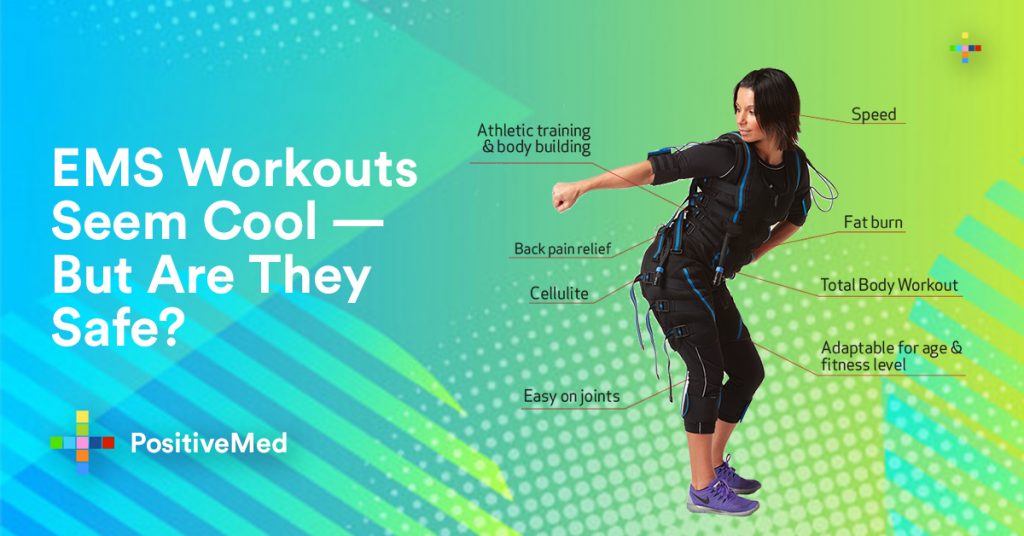You have probably come across photos of Ashley Graham or Hannah Bronfman on Instagram, exercising in futuristic suits with wires linked to their muscles. Perhaps you have heard about the new workout that “shocks” the muscles into exercising. Electrical muscle stimulation (EMS) workouts are a type of physical therapy that deals with injuries.
Ryan Yelle, PT, DPT, OCS, CSCS, is the clinical director at Professional Physical Therapy . He explains that physical therapists use EMS to help people recover from surgery or to rehabilitate injuries. EMS is commonly used if someone has muscular inhibition and weakness as a result of pain, swelling, and immobilization. For instance, after an anterior cruciate ligament (ACL) knee surgery, weakened quads can occur. Yelle says that EMS can “involuntarily activate” or awaken the quads to prevent a person from losing his or her muscle mass or function.

However, some fitness influencers and boutique workout aficionados have recently been discussing these workouts that use EMS technology. The EMS works by sending electrical impulses to your muscles to recruit more muscle fibers while increasing the intensity of strength-training routine. People are getting drawn to this technology that alleges to workout more muscles and improves your fitness within a short period of time.
As far as exercises are concerned, EMS seems special and some people might say they are not effective. Milo Bernstein, owner of Epulse which is an EMS workout facility in New York City, answers some of the questions about EMS.
How does EMS work?
For a muscle to contract, your brain should send an electrical impulse to neurons located in muscle fibers. This is exactly similar to what EMS does. It applies electrode pads to various parts of the muscle and trainers can send a small electrical signal that informs it to contract. This is the reason why EMS is helpful for people with an injury or who suffers a stroke and wants to retrain their brain to activate a muscle.
Is EMS painful?
According to Bernstein, it can feel odd for the first time although it is not necessarily painful. It will feel like a pulse as if someone is flicking your muscles with a rubber band quickly. “It is almost like a vibration”, he says. Despite the catchy name, EMS use a very small electric current that can’t even start a car or run a battery.
How does EMS help during an exercise?
Bernstein says that EMS machines help to activate more muscle fibers than you can with the standard strength exercise without EMS. “At Epulse people wear a vest and a pair of shorts with electrodes. A trainer will guide you through a series of simple bodyweight exercises, such as pushups, lunges, squats, and crunches. The level of electricity going to your body is constantly adjusted.”
How safe is EMS?
Bernstein says that not all EMS devices are 100% safe. The treatment should be carried by a physical therapist using a device that is approved by the Food and Drug Administration (FDA). Examples of fouls that the FDA has received include burns, shocks, pain, and skin irritation . According to the FDA, the use of electricity can lead to electrocution. Thus, research to find out the kind of an EMS a physical therapist is using.
“EMS is not suitable for everyone”, Bernstein states. “You shouldn’t use EMS if you have pacemakers or defibrillators because they can interfere with these machines. EMS is also not suitable for pregnant women or epileptic people. It is also advisable to talk with your doctor before trying EMS.”
Should one stop working out forever and switch just to EMS?
Though it sounds exciting, EMS will not give the same results like when you exercise normally. EMS can temporarily tone, firm, and strengthen your muscles, but it does not cause long-term improvements, according to FDA. In addition, EMS is quite expensive and is not a shortcut to exercise. Each session costs $125 at Epulse.
Edited by: Jessa (Jan. 28, 2019)








